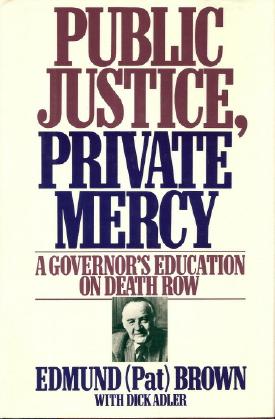 The following book review appeared in Harmony, November-December, 1989 and was revised most recently in December, 2004. Although old, this book is still valuable for its insights into the politics of the death penalty. Review of Public Justice, Private Mercy: A Governor's Education on Death Row, by Edmund (Pat) Brown with Dick Adler. New York: Weidenfeld & Nicolson, 1989, 171 pp. Mary Meehan The late Pat Brown, before his 1959-67 service as governor of California, was a district attorney who strongly supported the death penalty. In 1945 he was invited to witness the execution of a prisoner his office had prosecuted. "I told a couple of homicide detectives involved in the case that I planned to attend, and both of them quickly urged me not to," Brown recalled in this book. "When I asked them why not, these tough veteran police officers told me that if I did, I would never be able to push for a death sentence again." Brown took their advice. Later, however, he was troubled while prosecuting two men who had killed a service station owner during a robbery. The defense lawyer declared that Brown was handling the case personally because, if the men received the death penalty, Brown would be re-elected as district attorney. The defense lawyer was right. Brown, with his re-election in mind, had told his staff to "get me a lead-pipe cinch." Apparently conscience-stricken by his adversary's remark, he asked the jury to recommend life in prison without possibility of parole. They did so. Pat Brown was ambivalent about the death penalty for many years thereafter. He supported it as attorney general of California and when he was first elected governor, but at some point turned against it. He did not explain in this book just when he turned the corner, nor what--if anything--he promised to do about the death penalty during his election campaigns. But he said that, because of his oath to enforce state laws, he felt obliged to let people go to the gas chamber unless he had specific reasons to save their lives. Great ironies resulted. The same Gov. Brown who was urging his legislature to abolish the death penalty, and was commuting the death sentences of 23 prisoners, was also refusing to save the lives of 36 others. Politics sometimes affected his decisions, but not always in the crass sense of concern about his own political survival. Once, for example, a legislator from Kern County happened to hold the swing committee vote on a bill to help migrant workers--a bill Brown strongly supported. The legislator, for his part, strongly supported the death penalty; and a man was under sentence of death for raping, and helping to kill, a six-year-old girl in Kern County. Gov. Brown seriously considered clemency, because there were indications that the man had been mentally disturbed for many years. But the legislator who held the swing vote told Brown that his district would "go up in smoke" if the governor commuted the man's sentence. Brown declined to do so; the man was executed; and the migrant worker bill passed. Other Brown decisions seemed to result from an ambivalence about the death penalty that, I suspect, is shared by many who oppose it. An ardent supporter of gun control, Brown was more inclined to let convicts go to the gas chamber if they had killed with guns than with a knife or (in one actual case) with a bowling pin. It seems that the death penalty has its uses, even for some who generally oppose it. Brown was a decent man, though, and he made many good points against the death penalty. Because he was ambivalent for so long, and because he was honest about the politics of the issue, this might be a good book to buy and send to your own governor if you're in a death-penalty state. (In late 2004, the book was available for $1.69 and up on www.amazon.com.) Your governor might profit from Brown's experience and from his poignant comment that his power of life and death "was an awesome, ultimate power over the lives of others that no person or government should have, or crave. And looking back over their names and files now, despite the horrible crimes and the catalog of human weaknesses they comprise, I realize that each decision took something out of me that nothing--not family or work or hope for the future--has ever been able to replace." I wish that Brown had come out flatly in favor of life in prison, with no parole, as an alternative to the death penalty. This does, as he notes, have its own problems. Chief among them, at least in California, has been the state's failure to be consistent. In some cases, Brown commuted sentences to life in prison without the possibility of parole, but a later change in state law made the prisoners eligible for parole. In a few cases, Brown himself later made parole possible. In one such case, involving a man convicted of kidnapping and rape, the parolee committed at least two rapes and one murder after his release. Brown was stricken with feelings of "horror and guilt" when he learned of the man's new crimes. Cases of murderers who are paroled, and then commit more murders, may be more frequent than some death-penalty opponents want to admit. A recent Justice Department study, Capital Punishment, 2003, reported that of the 3,374 prisoners who were on death row that year, at least 272 had homicide convictions before commission of the murders or other capital crimes for which they received the death penalty. The question of the proper penalty for murder seems more acute when you make calculations based on another Justice Department study, Felony Sentences in State Courts, 2002, and realize that--of the convicted murderers sentenced by the states in that year--74 percent received neither a death sentence nor life in prison. (Only two percent were sentenced to death, a figure that most citizens might find amazing in view of the wrenching debates over executions.) Of the 74 percent, average time actually served was expected to be around twelve years. That is pretty scary if you value your own life and the lives of others. Many people support the death penalty more out of fear than a desire for vengeance. They have read or heard too many stories of murderers who were released and then killed more people. Some of us who oppose the death penalty share their concern about release. Indeed, some sentences are so light that they almost suggest contempt for the victims. In 1983 a Colorado man who had killed his wife was sentenced to two years in jail, with work release on weekdays. In 1988 a Virginian who had killed his three-month-old son was sentenced to one year in jail. In 1998 an elderly Virginia woman, convicted of beating her male companion to death, received a suspended sentence of ten years in prison. Her real punishment was ninety days of house arrest. No one should be surprised by our high murder rate when innocent life is rated so cheaply. Nor should anyone be surprised that public support for the death penalty is still high--ranging from 63 to 71 percent, according to polls in recent years. Many citizens believe the death penalty offers the only assurance that murderers will not kill again and that they will, in fact, be severely punished. Yet support for the death penalty drops significantly when those polled are asked about the alternative of life imprisonment with no parole. We should support that alternative if we want to abolish the death penalty and also reduce the terrible death toll from murder. Except for those proven to have been wrongly convicted--who should be cleared, released and financially compensated--pardon or commutation by a governor should be the only way out. This would allow occasional clemency for elderly convicts who are no longer a danger to society. But since this penalty ordinarily would be another version of "a life for a life," it would provide the sense that justice has been done. It would keep extremely dangerous people off the streets. And it might well be a stronger deterrent than the capriciously-administered death penalty. To the young, the hot-blooded and the impulsive, the prospect of a lifetime of obscurity in prison might seem worse than death. This, of course, is one reason why many death-penalty opponents cannot bring themselves to support life with no parole. Yet life imprisonment does not have to be either pointless or cruel. We can adopt the late Chief Justice Warren Burger's proposal of building prisons that are "factories with fences," so that prisoners can do something productive. Burger, a conservative, had a genuine and longstanding interest in prison reform. He probably understood that enforced idleness is one of the pointless cruelties of prison life. And he knew that those who are not serving life sentences need to develop work skills so they won't, in his words, "renew their warfare with society" after their release. Historically, the strongest resistance to prison labor has come from business and labor groups who fear cheap competition. Most prison workers receive far less than the minimum wage, although many also receive time off their sentences in exchange for work. But there is no reason why prison factories cannot pay regular wages, with the states' taking some of the money for prisoners' room and board and some to pay restitution to victims of crime. As Albert Camus wrote: "We know enough to say that this or that major criminal deserves hard labor for life. But we don't know enough to decree that he be shorn of his future--in other words, of the chance we all have of making amends." The victims of major crime, or at least their surviving families, should also have a chance to receive amends. The combination of "factories with fences" and systematic restitution would make this possible. Monetary restitution would ease the serious problems of families deprived of breadwinners. And the idea of restitution would ease the deep mental suffering that murder always leaves in its wake.  |